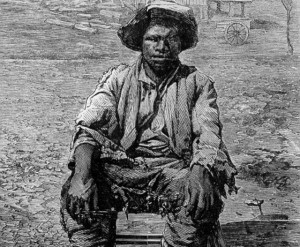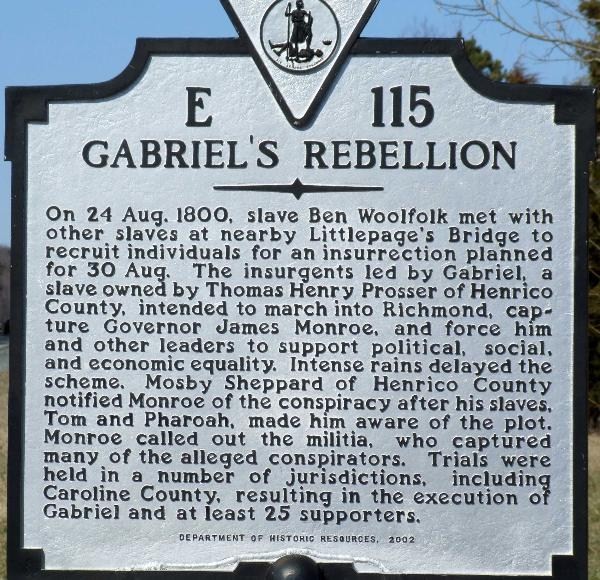Gabriel's Rebellion Marker
Introduction
Text-to-speech Audio
A marker on Route 301 just north of Richmond, VA in Henrico County marks the spot of Gabriel's Rebellion, one of the largest and most far-reaching rebellions in American history. The rebellion occurred in 1800 and put down by violent force and factors such as inclement weather and saboteurs inside the insurrection. Gabriel (sometimes attributed with the surname Prosser), was born in slavery in 1776 at Thomas Prosser's tobacco plantation. He organized and led a massive slave rebellion at the age of 24, including both white works and free African Americans in addition to enslaved people to kidnap then-Governor of Virginia James Monroe. The group planned on holding Monroe to negotiate with Richmond officials for a more equitable society. The rebellion ended in the trial and hanging of at least 25 members of the rebellion.
Images
A photograph of Gabriel.

The Virginia State Marker on Route 301 of Gabriel's Rebellion.

Backstory and Context
Text-to-speech Audio
Gabriel planned the insurrection for the night of August 30, 1800. Gabriel, a Blacksmith by trade, had sold his services to other plantations throughout Richmond and had spent time in Norfolk, Petersburg, and Albemarle Virginia. On those trips he had both earned money and acquired new acquaintances. These would later become an intimate part of his planned rebellion.
On the night of the August 30 there was a terrible storm. It left bridges and roads impassable so that many members of the revolution could not meet at the agreed location. Gabriel knew that the attack could not occur with the circumstances and rescheduled the rebellion for the next night.
In the meantime there had been rumor that a slave rebellion was in the planning. At first James Monroe ignored the warnings, but after he received word that two slaves had corroborated the report Monroe mobilized the state militia. Two slaves that were part of the insurrection surrendered information about the plans in exchange for a full pardon. It caused Gabriel to flee to Norfolk where he was later capture and forced to stand trial.
Gabriel’s trial was the court of “Oyer and Terminer”, a juryless court made specifically for slaves. It handed down a guilty verdict and Gabriel was hanged to death just two months after the foiled rebellion. His rebellion prodded the state of Virginia to enact laws that prohibited the gathering of slaves, the co-mingling of slave and free Black, and the hiring of free Blacks to reduce the chances of another incident.
Sources
http://newsone.com/2033315/gabriel-prossers-rebellion-1800/ http://www.pbs.org/wgbh/aia/part3/3p1576.html http://msuweb.montclair.edu/~furrg/spl/gabrielrevolt.html http://www.henricocitizen.com/index.php/news/article/failed_rebellion_had_wide_reaching_effect_2386#.VCuARvldVuw Egerton, Douglas R. Gabriel's Rebellion: The Virginia Slave Conspiracies of 1800 and 1802. Chapel Hill, NC: University of North Carolina Press, 1993. Nicholls, Michael L. Whispers of Rebellion: Narrating Gabriel's Conspiracy. Charlottesville, VA: University of Virginia Press, 2012. Schwarz, Philip J. "Gabriel's Challenge: Slaves and Crime in Late Eighteenth-Century Virginia", Virginia Magazine of History and Biography Volume 90, Issue 3, pp. 283–309, 1982.
